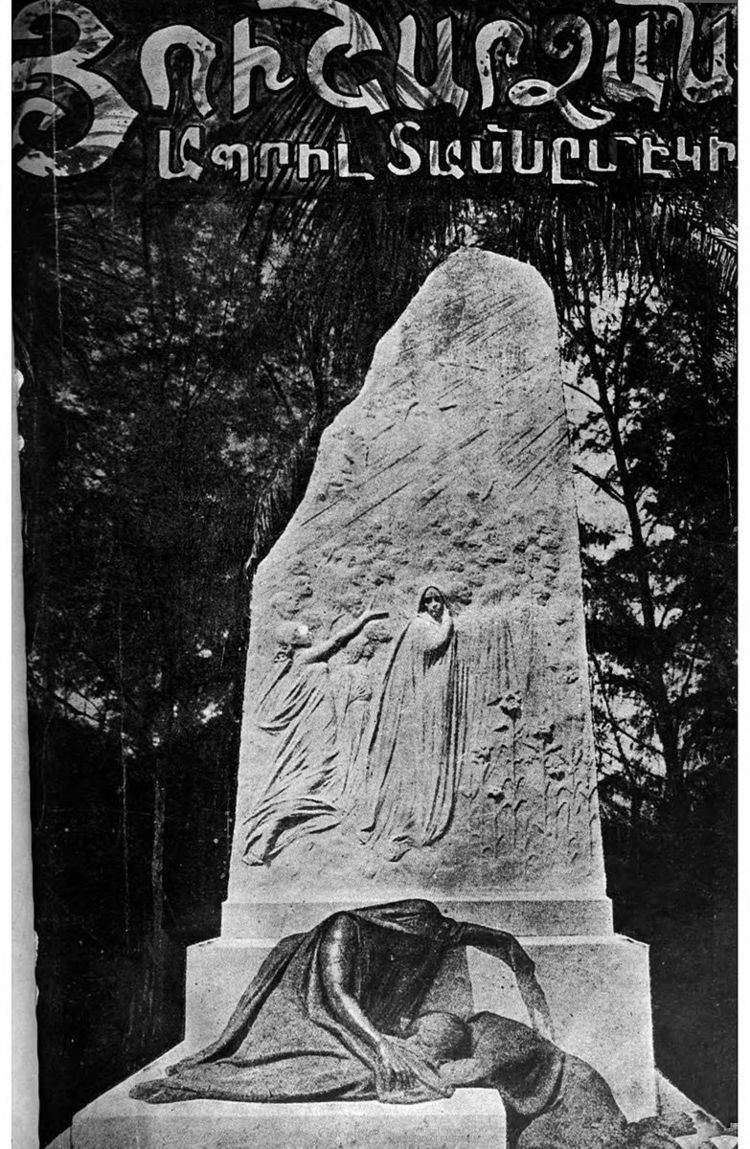 | ||
Similar Bosphorus, Şakirin Mosque, Zeyrek Mosque, Pera Museum, Grand Bazaar | ||
The Istanbul Armenian Genocide memorial, also known as Huşartsan, was a marble monument that became the first memorial dedicated to the victims of the Armenian Genocide. It was erected in 1919 at a site near Taksim Square in Istanbul, Ottoman Empire. The monument was located on the premises of the former Pangaltı Armenian Cemetery. In 1922, during the Occupation of Istanbul, the monument was dismantled and subsequently lost under unknown circumstances.
Contents
Background
The Armenian Genocide was the Ottoman government's systematic extermination of its minority Armenian subjects from their historic homeland within the territory constituting the present-day Republic of Turkey. The total number of people killed as a result has been estimated at between 1 and 1.5 million. In the aftermath of World War I, with the Ottoman Empire defeated, the Allied forces occupied various parts of the Ottoman Empire; the British seized control of Constantinople and the Bosphorus straits. During this period, the first commemoration of the Armenian Genocide was organized on 24 April (Rumi calendar: 11 April), the day that marked the beginning of the deportation of Armenian intellectuals. The commemoration, organized by a group of Armenian Genocide survivors, was held in Istanbul in 1919 at the local St. Trinity Armenian church. Many prominent figures in the Armenian community participated in the commemoration. Following its initial commemoration in 1919, the date became the annual day of remembrance for the Armenian Genocide.
Monument's inauguration
After the first commemoration, plans were implemented to build a monument dedicated to the victims of the genocide. A committee was formed to carry out the project. It was eventually erected in 1919 and was located on the premises of the Pangaltı Armenian Cemetery. The cemetery, which was to be later demolished and confiscated by the Turkish government in the 1930s, was located in today's Gezi Park near the Taksim Square in Istanbul. The monument became the first memorial dedicated to the victims of the Armenian Genocide.
In 1922, during the resurgence of the Turkish National Movement, the monument was dismantled and subsequently lost under unknown circumstances. According to historian Kevork Pamukçuyan, the base of the monument was last seen in the gardens of the Harbiye Military Barracks (which now houses the Istanbul Military Museum).
Legacy
The monument was featured on the cover of a 1919 book dedicated to the memory of the victims of the genocide written by Teotig, the prominent Armenian writer and publisher.
During the Gezi Park protests, various activists demanded that the memorial be rebuilt. Cengiz Algan, a member of a NGO called Dur De, expressed his support to having the monument rebuilt by saying:
The Kemalists seized the land from the Armenians in the 1940s. The stairs of the Gazi Park were built from Armenian gravestones. The Armenians were killed. Yet tens of thousands have survived and they are trying to prove the tragedy of their ancestors on these lands. We intend to remind people about the Genocide, not to conceal the truth. We want to inform visitors of the Gezi Park that a monument to the Armenian Genocide victims stood here in 1919. And we hope that one day a new monument to the Genocide victims will be built in this place.
